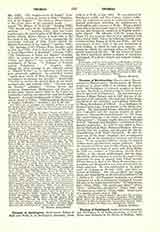

Thomas of Cantimpre, medieval writer, preacher, and theologian, b. of noble parentage at Leuw St-Pierre near Brussels, in the Duchy of Brabant, 1201; d. May 15, 1272. At the age of five his education began at Liege, where he spent eleven years mastering the difficulties of the trivium and quadrivium. At the age of sixteen he received the habit of the Canons Regular of St. Augustine in the Abbey of Cantimpre, where he was eventually elevated to the priesthood. In 1232, after fifteen years at Cantimpre, during which he was a constant source of edification to his religious brethren, he entered the Order of St. Dominic at Louvain. Immediately after his profession in the following year, he was sent to Cologne to pursue the higher theological studies of the order, under the tutelage of the illustrious Albert the Great. From Cologne, where he spent four years, he went to Paris, to the Dominican studium of St. James, to perfect himself in the sciences and to prepare for the apostolate of preaching. Returning to Louvain in 1240, he was made professor of philosophy and theology—an office he filled with rare distinction. He achieved equal success in the apostolate of preaching, in recognition of which the title of “Preacher General” was conferred upon him. His missionary activities extended throughout Brabant and into Germany, Belgium, and France. To his reputation for missionary zeal and eloquence he added the fame of authorship. In all seven works, treating of philosophy, theology, and hagiology, are attributed to his pen. His first and most important work is entitled “Opus de natura rerum”. In the composition of this great work, which contains twenty books, he spent fifteen years. “Bonum universale de apibus” is an allegory in which, employing the figure of bees, he treats of precepts concerning conduct and of the duties of superiors and subjects. This work, which had a wide vogue among spiritual writers for many centuries, was printed at Deventer (before 1478), at Paris, and three times at Douai (159’7, 1605, 1627). His other works treat of hagiology and are as follows: (I) “Vita Christinw virginis mirabilis dict”; (2) “Vita B. Margaritae Iprensis”; (3) “Vita Piae Lutgardia”; (4) “Vita Joannis abbatis primi monasterii Cantimpratensis et ejus Ecclesiae undatoris”; (5) “Supplementum ad vitam B. Marine d’Oignies a B.M. Jacobo de Vitriaco”.
JOHN B. O’CONNOR.

